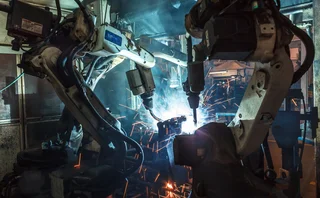Opening Cross: Buy, Build or Bust?
In light of two recent developments in the market data world, Max looks at the pros and cons of each side of the buy versus build debate.

If you choose to buy technology rather than build it in-house, the good news is that your project will generally come in cheaper than building it from scratch yourself, because you can leverage vendors’ “build-once-sell-many-times” economies of scale—and that includes not only the “raw materials” cost of hardware and software licenses, but also the cost of hiring staff—or the opportunity cost of taking them away from other projects—with the requisite skills. There’s also the fact that—especially in today’s fast-moving markets, where being first to market can deliver a fleeting yet worthwhile advantage—it’s quicker to deploy an off-the-shelf solution than building one yourself.
For example, if I need a new kettle, I’m going to walk the store and buy one. Even if I were an electrical engineer, I doubt I’d (a) be able to do that on the fly; (b) be able to buy the components cheaper than the cost of a new kettle; and (c) get it done in time to fulfill the client requirement—i.e., make myself a cup of coffee.
But on the other hand, if you buy the same tools as everyone else, you should expect to perform only as well—or as badly—as everyone else. And one of the reasons that firms pursue in-house builds is because they think they can deliver an advantage over the commodity tools available on the market. Indeed, that’s how a lot of low-latency developments eventually became mainstream—because initially firms built their own feed handlers or microwave networks. Once everyone else has caught up, they can buy off-the-shelf again, but in the meantime, they’ve had an advantage, and an opportunity to make more money.
Another reason firms are willing to build in-house—even when it might be clearly more expensive to do so—is to avoid vendor lock-in that could prove much more expensive in the long term. A kettle might be cheap, but when I also have to buy that manufacturer’s proprietary power adapter plus a special water filter to prevent limescale buildup, and an extension cord because this wonderful new kettle won’t fit where my old one did, the incremental costs add up—and that sunk investment makes me more likely to buy the same kettle again, rather than switching brands if I know I’m going to have to replace all those incidentals.
For example, low-cost data terminal provider Money.Net has begun building its own “next-generation” news service, leveraging a combination of traditional journalism and artificial intelligence to identify and break market-moving corporate news faster than traditional wires. The vendor chose to build the service itself—as it does with other aspects of its platform—because it feels this gives it more control over creativity, quality, build speed and costs, says chief executive Morgan Downey.
On the other hand, data inventory monitoring and cost control software vendor The Roberts Group has acquired Priory Solutions, a provider of similar services for the legal industry, in no small part because of Priory’s ability to provide detailed usage tracking around content delivered over the internet. This isn’t to say that TRG couldn’t build that functionality itself, given time, but the acquisition allows the vendor to start using it right away, and benefitting from an advantage that its competitors may not have.
Is there a third way that can not only make finding the right tools less of a stark choice, and gives you an element of both buy and build while mitigating the risks of each? Well, yes—at least, sort of—but I’ll save that discussion for another time.
Only users who have a paid subscription or are part of a corporate subscription are able to print or copy content.
To access these options, along with all other subscription benefits, please contact info@waterstechnology.com or view our subscription options here: https://subscriptions.waterstechnology.com/subscribe
You are currently unable to print this content. Please contact info@waterstechnology.com to find out more.
You are currently unable to copy this content. Please contact info@waterstechnology.com to find out more.
Copyright Infopro Digital Limited. All rights reserved.
As outlined in our terms and conditions, https://www.infopro-digital.com/terms-and-conditions/subscriptions/ (point 2.4), printing is limited to a single copy.
If you would like to purchase additional rights please email info@waterstechnology.com
Copyright Infopro Digital Limited. All rights reserved.
You may share this content using our article tools. As outlined in our terms and conditions, https://www.infopro-digital.com/terms-and-conditions/subscriptions/ (clause 2.4), an Authorised User may only make one copy of the materials for their own personal use. You must also comply with the restrictions in clause 2.5.
If you would like to purchase additional rights please email info@waterstechnology.com
More on Emerging Technologies
EY and Microsoft partner to bring agentic AI to risk management
The two firms are part of a deal to bring agentic AI processes to core operations like lending, servicing and risk, starting at Eurobank.
T. Rowe taps Genesis, Cusip lawsuit, FanDuel-CME tie-up, and more
The Waters Cooler: Tokenization and private markets, EuroCTP-BMLL, StateStreet-PriceStats, and more.
Tokenization & Private Markets: Where mixed data finds a needed partner?
Waters Wrap: Reading the tea leaves, Anthony predicts BlackRock’s Preqin deal, Securitize’s IPO, and numerous public comments from industry leaders are just the tip of the iceberg.
Fintech proposes borrowing AI standard from autonomous cars
Amid the rapidly growing use of financial AI, startup Martini.ai urges industry practitioners to coalesce around a common language to measure their progress and understand their own projects and capabilities.
Waters Wavelength Ep. 338: BBH’s Mike McGovern
This week, Mike McGovern of Brown Brothers Harriman talks with Tony about the importance of open architectures and the need for better data management in this increasingly AI-driven world.
LSEG and Nasdaq partner, MarketAxess’ new auctions, TXSE raises $250M, and more
The Waters Cooler: UBS executes its first tokenized fund transaction, LNRS opens APAC datacenter, MayStreet hits back in court, and more in this week’s news roundup.
Waters Wavelength Ep. 337: Interop.io’s Bob Myers
This week, Tony chats with Interop.io’s Bob Myers about agentic AI, the Model Context Protocol, and interoperability.
SS&C’s Bill Stone: RPA still important for agentic endeavors
The fintech is leaning on almost four decades in financial services and its many acquisitions to power AI deployment and meet the market’s needs.







